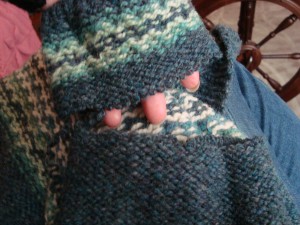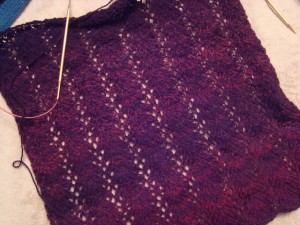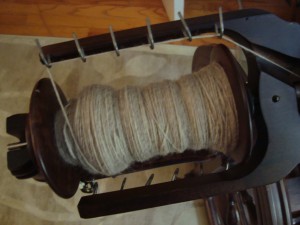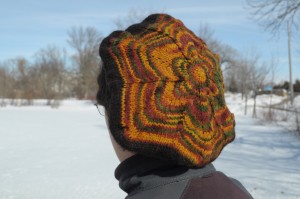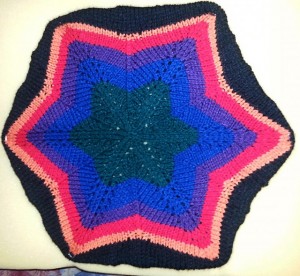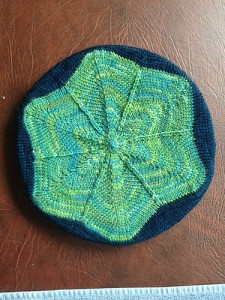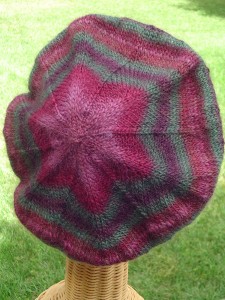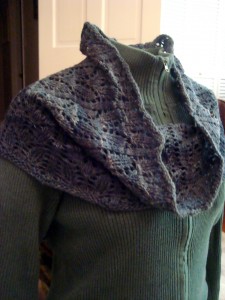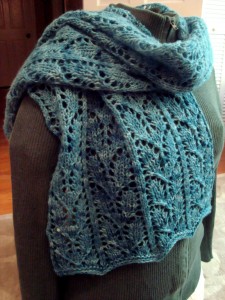We all have them: projects that seem inspired at the time, and less-than-inspiring later. There are the ones that don’t turn out the way you expect, and the ones where you pushed the envelope a little too far. And then there are those where the execution just didn’t live up to the dream, for whatever reason (materials, skill, maybe a little of both…).
I can usually see a dud coming, and rip back in time. But not always.
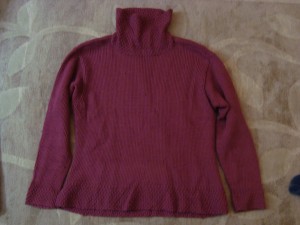
I knit this sweater back in 2008. I knew as soon as I finished it that it was bigger than I’d intended, but I thought there was a chance I’d wear it anyway. (That was my first mistake: excessive hope.) This was also my first lesson in shaping oversized garments. In a word, don’t: it makes them look too big rather than comfortably baggy. If you must shape, do it subtly.
I wore the sweater for a few months, maybe a season after I knit it, and never since. In the meantime, I’ve lost about 50 pounds, and what was once big is now hopelessly huge.
The second sweater is of roughly the same vintage.
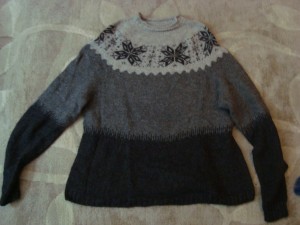
This was my first sweater on tiny needles. (Or at least they felt tiny at the time…looking back, they were size 3’s, which now feel pretty big.) It is also my only sweater in 100% alpaca yarn. I thought when I knit it that it might be too warm. That is not a problem. As someone who is always cold, an extra-warm sweater is something to be prized, not ignored. And yet, I never wear this.
The problem is with the yarn itself. Being 100% alpaca, it is quite slippery, which makes it hard to hold a bag on my shoulder or push up a sleeve with my hip when my hands are full (yes, apparently that’s an important feature of a sweater for me. I had no idea, until suddenly I couldn’t). Wearing it is like being coated in oil; everything is slippery, slippery, slippery. The alpaca also has a lot of drape. You can’t see it here, but the sweater grew significantly during the first few wearings. When it first came off the needles, it fit fine. But the (lack of) structure in a yoked sweater knit in the round combined with the slipperiness of the yarn and a sligtly-less-firm-than-usual gauge to give me a 10-20% increase in size. This garment was shaped well for a loose fit, and I still think it’s flattering, even after the additional weight loss. But if you look at the picture above, you can see that there are almost two different shoulder lines; one that was intended, and the other that emerged as the sweater practically melted off of me.
I pulled out the neckline once and reknit it, but it didn’t help. I’ve thought of lots of different fixes, but at the end of the day this sweater just never gets worn.
The third sweater is slightly more recent (sorry for the dark photo).
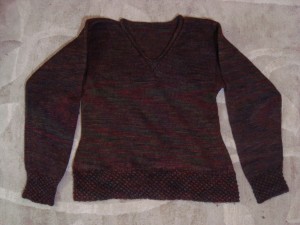
I knit this one back in 2010-11, with yarn from an indie dyer whose work I love. I bought the yarn online, which I never do unless I’ve seen it in person first. I ordered BFL worsted, but what came was a high-twist fingering weight. Think socks that rock heavyweight. I have no idea if that is her usual worsted or if something happened with the labels by mistake. But I loved the yarn, and I loved the color, so I set out to knit a sweater even if it wasn’t quite what I expected. I knit at a dense gauge, because that’s what I always do on a sweater. And it came out heavy.
At first, I didn’t think that was a problem, but as I wore it the weight started to bother me. Also, there were some construction details I didn’t like. I reknit the sleevecaps. I reinforced the shoulder seams to do a better job of holding up the sweater’s weight. I added a bit of an edging to the neck opening to fix the way it hung. None of it really worked. Like the others, I wore it for a season, and haven’t really touched it since.
Especially on this last sweater, I still love these yarns. I liked the sweaters at one point or another, but my enthusiasm waned after the initial excitement of completion wore off. For years now, I’ve been considering ripping them out and releasing the yarn for another project. I never wear them, and they take up storage space. The construction/structural integrity issues make them garments that I’m not likely to give away. I’m not inclined to keep things around simply because they took time and effort to knit. If they don’t serve a purpose, they’re going to be culled.
This year, the time felt ripe. And so, this week my projects have been ones of deconstruction rather than knitting. I unpicked ends, pulled out seams, and frogged with abandon. I got through the first two sweaters, but have hesitated on the alpaca because I”m worried about felting. The other two were fairly smooth wool yarns, but I’m not sure how well frogging will go for a fuzzy, loosely spun alpaca. I’m still thinking about that one.
I really liked playing with the crimped wool skeins, but sadly they needed to be relaxed if I want to knit with them again. So, after the frogging came a bath.
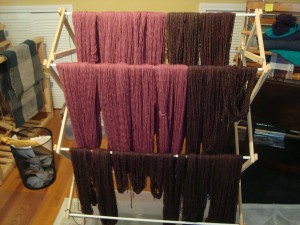
And I now have two sweaters’ worth of yarn to restash. I’m not sure that I’ll knit with it again right away, but I am glad that it’s been converted back from useless, abandoned garment to yarn with great potential.
